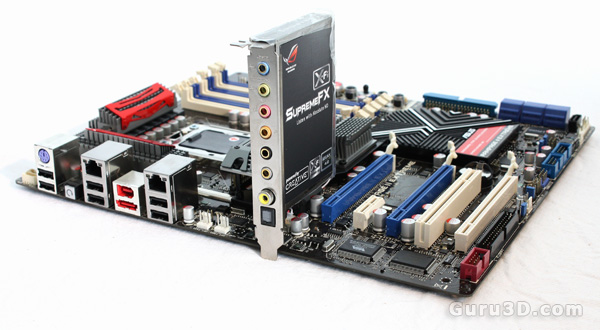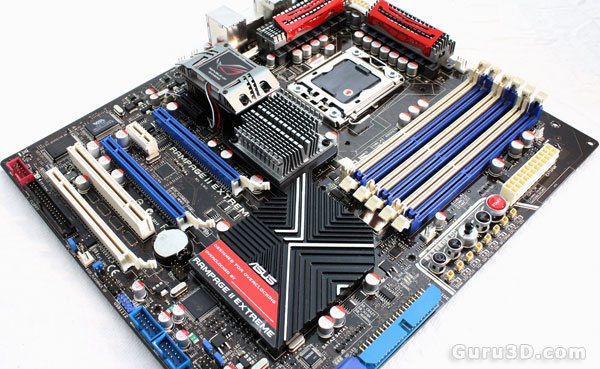2 - Examining the dark matter
Examining the dark matter
To be able to understand what we are doing today we need to briefly take you through some of the key components used for Lucifer. So I explained that we'll be building a DIY (Do It Yourself) X58 based system and sidetrack completely from the reference kit that Intel has been sending around.
So before we start, some custom parts we will be using I want to show to you first:
- Motherboard -- ASUS X58 Rampage 2 Extreme
- Memory -- OCZ PC3 16000 - Platinum Edition (2000 MHz 9-9-9)
- Cooling -- Noctua NH-C12P heapipe cooler with Nehalem mounting system.
These are some pretty nifty parts, and as such I wanted to talk you through them. First the mainboard, memory and then cooling.
ASUS X58 Rampage 2 Extreme
Guys, meet the ASUS X58 Rampage 2 Extreme. Since this is a GPU performance article, we won't go in-depth here but I think I can sum it up in one line for you: I actually fell in love with a motherboard. Prepare to get a woody. Designed for a small enthusiast market and likely manufactured with limited production numbers this is the top of the line ASUS X58 based motherboard. It comes from the ASUS Republic of Gamers (ROG) design group.
This motherboard is no laughing matter. The board has a multi-phase power management system, 16 phases for the CPU and 3 phases each for QPI/DRAM. You probably noticed it already, but the motherboard has this Creative labs X-Fi board on there. That actually comes with the motherboard itself and is called SupremeFX X-Fi. SupremeFX X-Fi utilizes established X-Fi technologies such as CMSS-3D and EAX to deliver multi-channel audio.
Do you see that hidden fan there, right above the chipset (Northbridge) heatsink? That's a VTT CPU Power Card ensuring some hefty overclocking. Next to the scrumptious six DIMM slots notice a set of controls and connectors on the edge of the board labeled 'Extreme OC'. This is the iROG microcontroller -- there's even a little joystick there, which enables you to make real-time changes to your PC's core frequency, voltage and other parameters using the joystick-like control on the motherboard itself.
Much like the ASUS P6T Deluxe (which we'll have a review on this week), the Rampage Extreme II has three PCI-E graphics slots, the Rampage Extreme II however can handle 3-way SLI and CrossFire.
Just below the Northbridge fan we can see the black PCIE 1x slot for the SupremeFX daughter-board, and below that, three PCIe 16x slots for multiple graphics card setups. Two graphics cards (blue slots) will both provide x16 bandwidth, but when running Tri-SLI or three cards in CrossfireX mode the top slot provides 16x bandwidth and the remaining two provide 8x. Additionally, there is one remaining PCIe 1x and PCI slot.
The Rampage II Extreme has 1x IEEE1394; 1x floppy drive; 3x SATA (including extra 1394 module) ports and the front panel connectors. An interesting fact is that the Rampage II Extreme has a dual BIOS. There is a jumper available for selecting which BIOS you are going to boot from. Right, let me end it before it turns into a full motherboard review.
Very expensive, but this might be the best designed motherboard I've ever had my hands on.


